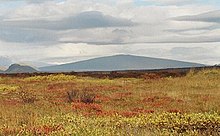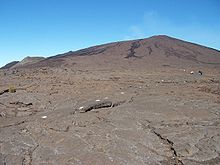Shield volcano

A shield volcano is a special form of a volcano . The name comes from the shield-like bulging shape of this type of volcano.
Emergence
The cause of the typical shape is the outflow of very thin and therefore fast flowing, low-gas lava . This is usually of a basaltic composition and usually contains less than 52% silicon dioxide (SiO 2 ). When it flows out, it is approx. 1000 ° C to 1250 ° C. The place of origin of the extracted magma is the upper mantle . The angle of repose of shield volcanoes be due to the high flow rate of the lava (up to 60 km / h) only about 5 °, that is, there These are all very gently sloping, but extended cone. Shield volcanoes are also known as red volcanoes according to their eruption behavior . They convey gigantic masses of thin ( red-hot ) lava, which emerge effusively and can spread widely even on flat slopes . Shield volcanoes are therefore not pronouncedly raised. The ratio between height and foot diameter is usually only 1:20 to 1:10.
Occurrence
Most shield volcanoes are located within the lithospheric plates above hotspots (e.g. Hawaii ) as well as at diverging plate edges on the mid-ocean ridges (e.g. Iceland ) or in rift zones such as the East African Rift . Of the 1500 active volcanoes worldwide, 180 are shield volcanoes.
One of the most famous shield volcanoes is the Mauna Loa in Hawaii , the largest of the almost completely submarine Pūhāhonu with a volume of about 148,000 km³. The shield volcanoes that led to the creation of the Hawaiian Islands are the largest volcanoes on earth .
Other active shield volcanoes can be found on Reunion Island , e.g. B. the volcano Piton de la Fournaise .
The largest known shield volcano and at the same time the highest mountain in the solar system is Olympus Mons on the planet Mars , with a height of 26 kilometers above the surrounding lowlands.
See also
Web links
- at the Global Vulcanism Program (English)
- V. Camp: Shield volcanoes , How Volcanoes Work , Dept. of Geological Sciences, San Diego State University (English)
- R. Andrew, A. Gudmundsson: Distribution, structure, and formation of Holocene lava shields in Iceland, Journal of Volcanology and Geothermal Research, Vol. 168, Iss. 1-4, Nov. 2007, 137-154 (Science Direct, Abstract, English)
- Ken Hon, ea: Field interpretation of active volcanoes. A handbook for viewing lava , Geology Dept., University of Hilo, Hawaii, 2008 (especially p. 47 ff.) (PDF, English; 8.3 MB)
Individual evidence
- ↑ Number of active volcanoes in the Global Volcanism Program (English)
- ↑ Gerd Simper: Understanding and experiencing volcanism . Feuerland Verlag, Stuttgart 2005, ISBN 978-3-000-15117-0 , p. 38.
- ↑ Michael O. Garcia, Jonathan P. Tree, Paul Wessel, John R. Smith: Pūhāhonu: Earth's biggest and hottest shield volcano . In: Earth and Planetary Science Letters . Volume 542. Elsevier, April 18, 2020, doi : 10.1016 / j.epsl.2020.116296 .


